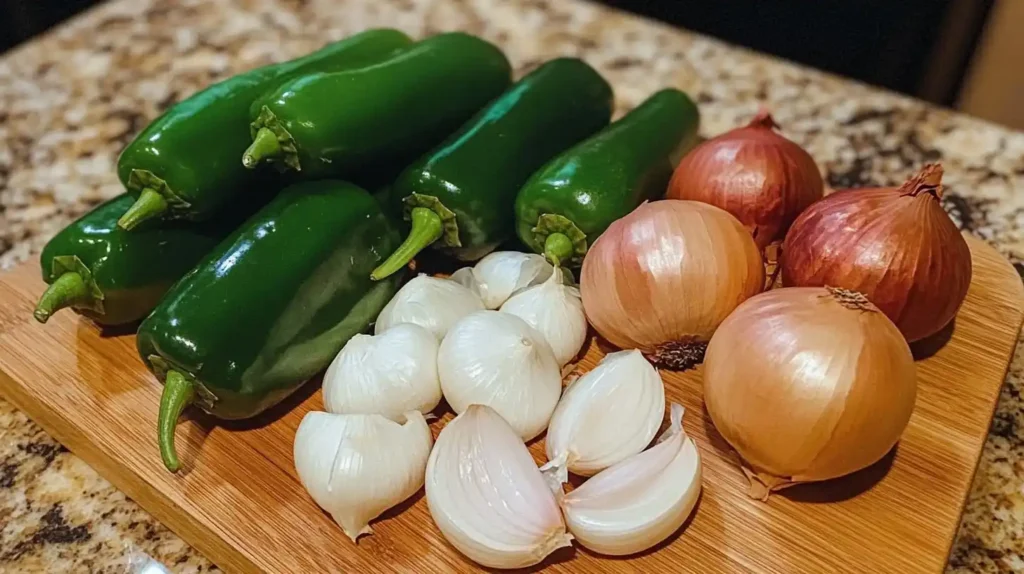When you crave a spicy and creamy dish, cream of jalapeño soup is hard to beat. But if you’re wondering, “How many calories are in cream of jalapeño soup?”, this guide breaks it all down. Whether you’re watching your intake or looking for lighter options, understanding its calorie count is essential.
In this guide, we’ll explore everything from what influences the calorie count in cream of jalapeño soup to how you can enjoy it guilt-free. Along the way, you’ll learn about variations, nutritional benefits, and even low-calorie options. If you’re curious about adapting recipes to suit different dietary preferences, check out our guide on Is Chili’s Baked Potato Soup Vegetarian?. Let’s dive in!
Table of contents
- What Factors Influence the Calorie Content of Cream of Jalapeño Soup?
- Preparation Methods for Cream of Jalapeño Soup
- How Many Calories Are in Homemade Cream of Jalapeño Soup ?
- Nutritional Breakdown: More Than Just Calories (Cream of Jalapeño Nutritional Value)
- How to Lower the Calories in Cream of Jalapeño Soup
- FAQs About Cream of Jalapeño Soup
- Health Benefits of Jalapeños in Soup
- Tips for Enjoying Cream of Jalapeño Soup Without Guilt
- Final Thoughts
What Factors Influence the Calorie Content of Cream of Jalapeño Soup?
The calorie content of cream of jalapeño soup is influenced by key factors, primarily the ingredients and preparation method. These variables can make a big difference in the overall nutritional value of the dish.
Common Ingredients and Their Impact
- Jalapeños: These peppers are naturally low in calories (about 4 calories per pepper). They add flavor and spice without significantly increasing the calorie count.
- Cream: Heavy cream is a high-calorie ingredient, with around 50 calories per tablespoon. Recipes that use less cream or substitute it with low-fat options are lower in calories.
- Butter or Oil: Many recipes use butter for richness, contributing approximately 100 calories per tablespoon.
- Broth: Chicken or vegetable broth is relatively low in calories, averaging 10–15 calories per cup.

Preparation Methods for Cream of Jalapeño Soup
The way you prepare cream of jalapeño soup greatly influences its calorie count, flavor, and nutritional value. Whether you make it at home or opt for store-bought options, each method has its unique benefits and considerations.
Homemade Preparation
Making the soup from scratch gives you full control over the ingredients and cooking process. Here’s how:
Step-by-Step Process for Homemade Soup
- Roast the Jalapeños
Roasting enhances their flavor and reduces bitterness. Place the peppers on a baking sheet and roast them at 400°F (200°C) for 10–15 minutes, or until their skins are charred. Peel the skins off after cooling. - Sauté the Base Ingredients
In a pot, sauté diced onions and garlic in a teaspoon of olive oil or butter until fragrant. This adds depth to the soup’s flavor without adding many calories. - Simmer with Broth
Add chicken or vegetable broth to the pot, along with the roasted jalapeños. Let it simmer for about 15 minutes to allow the flavors to blend. - Blend for Creaminess
Use an immersion blender or transfer the soup to a countertop blender to puree until smooth. This step helps create a creamy texture even before adding cream. - Add Cream or a Substitute
Stir in heavy cream, low-fat milk, or a dairy-free alternative like almond or cashew milk, depending on your dietary preference.
Advantages of Homemade Soup
- Customizable: Adjust the spice level, calorie count, and ingredients to suit your taste.
- Lower Sodium: Avoid the high salt content often found in store-bought versions.
- Fresh Ingredients: Using fresh produce boosts the soup’s flavor and nutritional value.
Store-Bought Options
If time is short, store-bought soups can be a convenient alternative. These come in ready-to-eat or condensed forms.
Ready-to-Eat Soups
- Require no preparation simply heat and serve.
- Many brands offer “light” or low-calorie versions.
Condensed Soups
- Need to be mixed with water or milk before heating.
- Using water keeps the calorie count lower, while adding milk makes it richer.
Things to Watch For
- Sodium Levels: Store-bought soups can contain up to 800–900 mg of sodium per serving. Look for low-sodium options.
- Added Preservatives: These may slightly alter the flavor compared to homemade recipes.
Cooking Tips for Healthier Soup
- Opt for non-stick pans to reduce the need for oil or butter during sautéing.
- Use a slow cooker or instant pot for a hands-off approach that locks in flavor.
- Incorporate roasted vegetables, like tomatoes or bell peppers, for added nutrition and a richer taste.
How Many Calories Are in Homemade Cream of Jalapeño Soup?
Understanding the calorie content of cream of jalapeño soup is essential for making informed dietary choices. Let’s break down the calorie counts for homemade versions and store-bought options to give you a clearer picture.
Homemade Cream of Jalapeño Soup
Homemade recipes often have more variation because you can adjust ingredients to suit your taste or dietary needs. Here’s a typical breakdown:
- Heavy Cream: Two tablespoons contribute around 100 calories.
- Jalapeños: Low in calories, adding just 4 calories per pepper.
- Chicken or Vegetable Broth: About 10–15 calories per cup.
- Butter or Oil: Adds approximately 100 calories per tablespoon.
For a standard serving (1 cup), you can expect 150–200 calories, depending on the amount of cream and butter used.
Store-Bought Options
Store-bought versions vary widely in calorie count due to added preservatives, thickeners, and sodium. For example:
- Tasty Classics Cream of Jalapeño Soup contains about 180 calories per serving (1 cup).
- Condensed options, like those found on Eat This Much, typically range from 110 to 150 calories.
Factors Influencing Store-Bought Calorie Counts
- Condensed Soups: Require water or milk, which can either dilute or enhance the calorie content.
- “Light” Versions: Often use thickeners or non-dairy substitutes to lower calories, making them a great choice for those watching their intake.
Nutritional Breakdown: More Than Just Calories (Cream of Jalapeño Nutritional Value)
When it comes to cream of jalapeño soup, calories are just one piece of the puzzle. This soup offers a mix of nutrients that can influence your overall health. Let’s dive into the details of what’s inside your bowl.
Macronutrient Breakdown
- Protein: Depending on the recipe, you’ll get around 3–5 grams of protein per serving. If you use chicken broth or add shredded chicken, the protein content will be higher.
- Fat: The soup’s creamy texture comes from fat. A serving typically contains 8–12 grams of fat, much of which is saturated if using heavy cream or butter.
- Carbohydrates: With thickeners like flour or cornstarch, you’ll find about 10–15 grams of carbs per serving. Using alternatives like almond flour can reduce this.
Micronutrients
- Vitamins: Jalapeños are packed with vitamin C, providing a boost to your immune system. A single serving of soup can supply about 20–30% of your daily vitamin C needs.
- Minerals: Broth-based recipes add small amounts of potassium and magnesium, while canned versions might include added calcium.
Additional Considerations
- Sodium: Store-bought soups can have 700–900 mg of sodium per serving, which is almost half the recommended daily intake. Homemade versions allow you to control the salt.
- Sugar: Most recipes contain little to no sugar, though some store-bought options may have small amounts for flavor balance.
How to Lower the Calories in Cream of Jalapeño Soup
If you love cream of jalapeño soup but want to enjoy it without the extra calories, there are plenty of ways to lighten it up. Small changes to the ingredients and cooking methods can make a big difference while keeping the soup flavorful and satisfying.
Here are a few tips for reducing the calorie count in cream of jalapeño soup:
- Swap heavy cream for low-fat milk or a dairy-free alternative like almond milk.
- Use vegetable broth instead of cream-based stocks.
- Add texture by blending roasted vegetables like cauliflower instead of using flour-based thickeners.

Ingredient Substitutions
- Swap Heavy Cream for Low-Fat Options
- Substitute heavy cream with low-fat milk or unsweetened almond milk. This reduces the fat content significantly without compromising too much on creaminess.
- Try Greek yogurt as a thickener. It adds protein and keeps the calorie count lower.
- Choose Low-Calorie Thickeners
- Replace flour or cornstarch with cauliflower puree. This adds creaminess and fiber without the extra carbs.
- Blend some of the soup’s vegetables to naturally thicken the base.
- Reduce Butter or Oil
- Cut the butter or oil in half. Using just 1 teaspoon instead of 1 tablespoon can save over 80 calories.
Cooking Tips for a Low-Calorie Cream of Jalapeño Soup
- Use vegetable broth instead of cream-based stocks. Vegetable broth has only 10–15 calories per cup, while cream-based options can triple that.
- Opt for roasting jalapeños instead of sautéing them in oil. This enhances their flavor with no added fat.
Store-Bought Alternatives
- Look for “light” or “reduced-fat” versions of canned cream of jalapeño soups. These options often have about 90–120 calories per serving.
- Avoid soups with high sodium. Check labels to find versions with less than 500 mg of sodium per serving.
FAQs About Cream of Jalapeño Soup
Here are some frequently asked questions about cream of jalapeño soup, along with clear and concise answers to help you make informed choices.
How many calories are in a serving of homemade cream of jalapeño soup?
A typical serving of homemade cream of jalapeño soup contains 150–200 calories, depending on the ingredients used. Adjusting the cream and butter can lower this count.
Are there low-calorie store-bought options?
Yes! Some brands offer “light” or reduced-fat versions of cream of jalapeño soup. These can range from 90–150 calories per serving. Check labels for sodium content, as store-bought soups can be high in salt.
Is cream of jalapeño soup suitable for weight-loss diets?
It can be! By using low-calorie substitutes like skim milk or vegetable broth, you can enjoy a lighter version of this soup that fits well into most weight-loss plans.
How can I make a vegan or dairy-free version?
- Substitute heavy cream with unsweetened coconut milk or cashew cream.
- Use vegetable broth instead of chicken stock.
- Ensure any thickeners used, such as flour, are plant-based.
What’s the calorie difference between homemade and canned soup?
Homemade soup often has a wider calorie range (150–200 per serving) because you control the ingredients. Canned soups tend to be more consistent, with most options falling between 110 and 180 calories per serving.
Health Benefits of Jalapeños in Soup
Jalapeños do more than just add a spicy kick to cream of jalapeño soup—they also offer several health benefits. These small but mighty peppers are packed with nutrients that can support your overall well-being.
1. Rich in Vitamin C
Jalapeños are an excellent source of vitamin C, which supports your immune system and promotes healthy skin. Just a few peppers in your soup can provide 20–30% of your daily vitamin C needs.
2. Boosts Metabolism
Jalapeños contain capsaicin, a compound that gives them their signature heat. Capsaicin has been shown to:
- Increase your metabolism.
- Promote fat burning.
- Help with weight management when included as part of a balanced diet.
3. Supports Heart Health
These peppers are also rich in antioxidants, which can help reduce inflammation and improve heart health. Regular consumption of antioxidant-rich foods may lower your risk of heart disease.
4. Aids Digestion
The heat from jalapeños stimulates your digestive system and may even help improve gut health by encouraging better circulation and enzyme production.
5. Low in Calories
Jalapeños are naturally low in calories, making them a guilt-free addition to soups, salads, and other dishes. This makes them an ideal ingredient for those watching their calorie intake.
Tips for Enjoying Cream of Jalapeño Soup Without Guilt
Jalapeños do more than just add a spicy kick to cream of jalapeño soup they also offer several health benefits. These small but mighty peppers are packed with nutrients that can support your overall well-being.
1. Rich in Vitamin C
Jalapeños are an excellent source of vitamin C, which supports your immune system and promotes healthy skin. Just a few peppers in your soup can provide 20–30% of your daily vitamin C needs.
2. Boosts Metabolism
Jalapeños contain capsaicin, a compound that gives them their signature heat. Capsaicin has been shown to:
- Increase your metabolism.
- Promote fat burning.
- Help with weight management when included as part of a balanced diet.
3. Supports Heart Health
These peppers are also rich in antioxidants, which can help reduce inflammation and improve heart health. Regular consumption of antioxidant-rich foods may lower your risk of heart disease.
4. Aids Digestion
The heat from jalapeños stimulates your digestive system and may even help improve gut health by encouraging better circulation and enzyme production.
5. Low in Calories
Jalapeños are naturally low in calories, making them a guilt-free addition to soups, salads, and other dishes. This makes them an ideal ingredient for those watching their calorie intake.
Final Thoughts
Cream of jalapeño soup is a delightful blend of creamy richness and spicy heat that can fit into almost any diet with the right adjustments. By understanding its calorie content and nutritional breakdown, you can make informed choices that suit your lifestyle and health goals.
Whether you prefer making it from scratch or choosing a store-bought version, there are plenty of ways to enjoy this soup guilt-free. Using simple substitutions, such as low-fat milk or vegetable broth, can significantly reduce the calorie count. Adding nutrient-dense ingredients like spinach, kale, or beans not only enhances the soup’s health benefits but also makes it more satisfying.
Jalapeños themselves offer impressive health perks, from boosting your metabolism to supporting your immune system. With their low-calorie nature and spicy kick, they’re a fantastic ingredient to include in a variety of meals.
So the next time you crave a bowl of cream of jalapeño soup, remember that you can savor it while staying mindful of your nutrition. Make small changes, experiment with ingredients, and enjoy this comforting dish with confidence!

